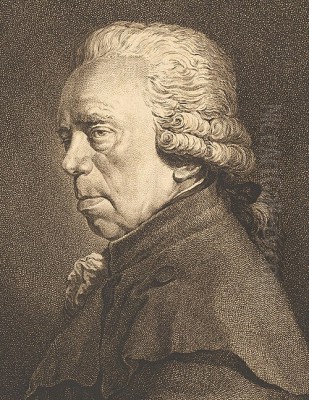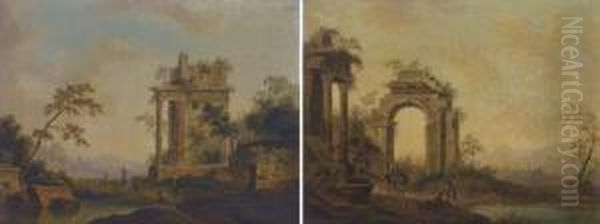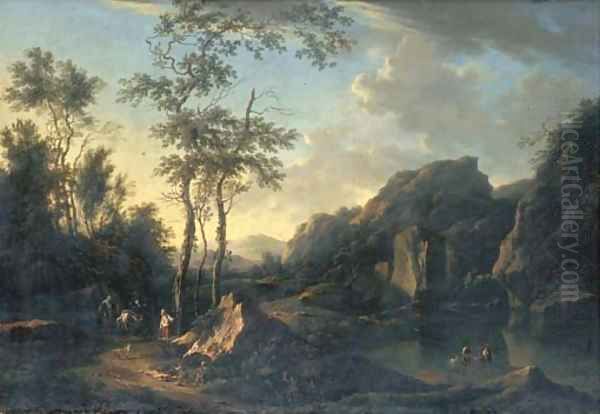
Johann Christian Brand stands as a pivotal figure in the evolution of Central European landscape painting during the 18th century. An Austrian artist born in Vienna, his life (1722-1795) spanned a period of significant artistic transition. Brand skillfully navigated the currents of late Baroque, Rococo, and emerging Neoclassical sensibilities, ultimately forging a distinct path that emphasized both observation of nature and refined artistic composition. His work, particularly his evocative landscapes, and his influential role as an educator cemented his legacy as a key contributor to Austrian and Hungarian art history.
Early Life and Artistic Formation
Johann Christian Brand was born into an artistic family in Vienna in 1722. His initial training came directly from his father, Christian Hilfgott Brand (c. 1695–1756), who was himself a respected landscape painter. This early exposure within a professional artistic household provided a solid foundation for the young Brand's burgeoning talent. Seeking formal education, he enrolled in the prestigious Vienna Academy of Fine Arts (Akademie der bildenden Künste Wien) around 1736.
At the Academy, Brand's artistic horizons expanded under the guidance of several notable figures. He continued to learn from his father but also studied with other masters active in the vibrant Viennese art scene. Key among his instructors was Josef Orient (1677–1747), another established landscape painter known for his detailed works. Brand also became associated with the circle around Jacob Matthias Schmutzer (1733–1811), who later founded an influential engraving academy within the larger institution. A crucial influence was Franz Edmund Weirotter (1733–1771), a gifted landscape painter and etcher whose position Brand would eventually inherit. This comprehensive training exposed him to various techniques and stylistic approaches prevalent in Vienna at the time.
Developing a Style: Influences and Innovation
Brand's mature artistic style represents a fascinating synthesis of diverse European traditions. He demonstrated a deep appreciation for the naturalism characteristic of 17th-century Dutch landscape painting, evident in his careful observation of terrain, foliage, and atmospheric effects. Artists like Jacob van Ruisdael or Meindert Hobbema seem to echo in his attention to detail and the textures of the natural world. However, Brand did not merely imitate; he infused this realism with the elegance and lighter touch associated with French Rococo aesthetics.

This Rococo influence, perhaps absorbed through contemporaries or exposure to French art, manifests in the graceful composition of his scenes and sometimes in the delicate rendering of figures populating his landscapes. Furthermore, Brand engaged with the tradition of the classical idealized landscape, pioneered by artists like Claude Lorrain. He often structured his views with a sense of balance and harmony, sometimes incorporating classical ruins or pastoral themes. Yet, crucially, Brand combined these idealized elements with a growing commitment to depicting specific, recognizable locations, moving beyond generic scenery towards topographical accuracy – a trend gaining momentum in the latter half of the 18th century.
Career Path and Patronage
After completing his studies, Brand sought opportunities beyond Vienna. He spent a period in Pressburg (modern-day Bratislava, Slovakia), then a significant city within the Habsburg Monarchy and the Kingdom of Hungary. There, he served as a court painter to the influential Hungarian nobleman, Count Pálffy. During this time, his work included portraiture, demonstrating his versatility, though landscape remained his primary passion. This engagement provided valuable experience and connections within aristocratic circles.
Upon returning to Vienna, Brand's reputation grew steadily. His skill in landscape painting attracted the attention of the highest echelons of society, including the Imperial Court. He received commissions to create representative works, contributing to the artistic milieu surrounding the Habsburg dynasty under Empress Maria Theresa. This imperial patronage was a significant marker of success and recognition. His standing was formally acknowledged in 1766 when he was granted the prestigious title of Kammermaler (Court Painter), signifying his official role within the imperial household's artistic establishment.
The Landscape Professor
Brand's contributions extended beyond his own artistic output; he became a highly influential educator. In 1771, he began teaching at the Vienna Academy, initially as an assistant. Following the untimely death of Franz Edmund Weirotter in the same year, Brand was appointed Professor of Landscape Painting in 1772, taking over Weirotter's landscape class, likely within the structure associated with Jacob Matthias Schmutzer's part of the Academy. This position allowed him to shape the next generation of landscape artists in the Habsburg lands.

As a professor, Brand was known for advocating methods that were relatively innovative for the time. He placed a strong emphasis on drawing and painting directly from nature (plein air sketching), encouraging students to observe the nuances of light, atmosphere, and topography firsthand. While academic tradition often prioritized studio work based on established formulas and master copies, Brand's approach fostered a more direct engagement with the natural world. This pedagogical focus significantly impacted the development of landscape painting in Vienna and influenced art education in Hungary, contributing to the genre's growing importance and realism. Although specific student names are scarce in readily available records, his long tenure ensured his methods influenced numerous aspiring artists.
Notable Works and Locations
Johann Christian Brand's oeuvre primarily consists of landscapes, often depicting the environs of Vienna, the Danube River valley, and areas he visited during his travels, potentially including parts of modern-day Slovakia and the Czech Republic. His works are characterized by a refined technique, careful composition, and a sensitive handling of light and atmosphere, effectively capturing the specific character of the locations he painted.
Among his representative works, Sandberg (dated 1776) exemplifies his ability to render a specific location with both accuracy and artistic sensibility. Another mentioned title, Bisambergis, likely refers to the Bisamberg hill near Vienna, a frequent subject for artists depicting the local scenery. Works with titles recorded in Czech, such as Pobřežní krajina s pastevci (Coastal Landscape with Shepherds, possibly the work cited as Pobřežna krmel, 1790) and perhaps a view related to the Klínovec mountain region (Klino zdarma, 1792), suggest his travels and interest in depicting landscapes in Bohemia or Moravia. These paintings showcase his mature style, blending detailed observation with a harmonious, often tranquil, mood. He frequently included small figures (staffage) that animate the scenes and provide scale, integrating human activity within the broader natural setting. His numerous drawings and etchings further attest to his dedication to landscape representation.
Artistic Circle and Connections
Throughout his career, Johann Christian Brand moved within a vibrant artistic network. His primary connection was, of course, his father, Christian Hilfgott Brand, his first teacher and a fellow landscape painter, allowing for a unique familial artistic dialogue. His teachers at the Academy, Josef Orient and Franz Edmund Weirotter, were significant figures who shaped his early development. The engraver Jacob Matthias Schmutzer was another important figure within the Academy structure where Brand taught.
Brand's work shows an awareness of broader European trends. He was connected, possibly through prints or travel, to the work of French artists like Jean-Georges Pillement (1728–1808), known for his Rococo landscapes and decorative designs. The influence of earlier Dutch masters and the classical tradition of Claude Lorrain is also apparent. Within Vienna, he would have been aware of, and likely interacted with, leading figures of the Austrian Baroque and Rococo, such as the dominant court portraitist Martin van Meytens (1695–1770) and the great fresco painters Paul Troger (1698–1762) and Franz Anton Maulbertsch (1724–1796), even if their primary genres differed. The presence of Bernardo Bellotto (Canaletto's nephew, 1721–1780), who worked in Vienna creating detailed cityscapes, also formed part of the artistic context. Furthermore, Brand's work resonates with the idyllic sensibilities found in the landscapes of Swiss artist and poet Salomon Gessner (1730–1788), whose works were popular across Europe. His most powerful connection was arguably his patronage by Empress Maria Theresa, with whom he reportedly collaborated on landscape studies near Devín Castle in 1774.
Style Evolution and Reception
Brand's artistic journey reflects a gradual evolution. While his early works might show a closer adherence to the detailed style of his father or the prevailing late Baroque conventions, his mature style developed towards a greater synthesis of observed reality and Rococo grace. Sources suggest a potential shift later in his career towards a more expressive handling of paint and a heightened sensitivity to color and light, moving away from purely topographical representation towards capturing the mood and atmosphere of a scene.
This development placed him at an interesting juncture in art history. He wasn't a revolutionary figure in the dramatic sense, but his work embodies the transition occurring in landscape painting during his lifetime. His emphasis on direct observation and specific locations prefigures 19th-century realism, while his compositional elegance retains links to Rococo aesthetics. Any "controversy" surrounding his work likely stemmed from discussions about the direction of landscape art – the balance between idealized beauty and naturalistic depiction, or the merits of his plein air teaching methods compared to stricter academic traditions. His position as Court Painter and Academy Professor indicates he was generally well-regarded and successful within the established art system of his time.
Legacy and Influence
Johann Christian Brand's legacy lies in his significant contribution to the establishment of landscape painting as a respected and independent genre within Austrian art. He successfully blended Netherlandish realism, French elegance, and classical composition into a distinctive style that resonated with the tastes of his era while also pointing towards future developments. His depictions of the Austrian and surrounding landscapes provided a valuable record and artistic interpretation of the region.
His role as Professor of Landscape Painting at the Vienna Academy was arguably as impactful as his paintings. Through his teaching, emphasizing direct study from nature, he influenced a generation of artists in Vienna and beyond, particularly impacting the course of landscape painting in Hungary. He stands as a key transitional figure, helping to steer landscape art away from the purely decorative or idealized modes of the Baroque towards the more naturalistic and eventually Romantic approaches of the late 18th and early 19th centuries. His work marks a crucial phase in the development of Central European art.
Conclusion
Johann Christian Brand was more than just a skilled painter; he was an important educator and a stylistic innovator within the context of 18th-century Austrian art. Born into an artistic family and trained by notable masters, he forged a successful career marked by prestigious appointments and imperial patronage. His landscapes, celebrated for their blend of detailed observation, Rococo grace, and sensitivity to light, captured the beauty of the Viennese countryside and beyond. As a professor, he championed the study of nature, influencing countless students and contributing significantly to the rise of landscape painting as a major genre in Central Europe. His life and work provide a fascinating window into the artistic transformations of the late Baroque and the dawn of modern landscape art.